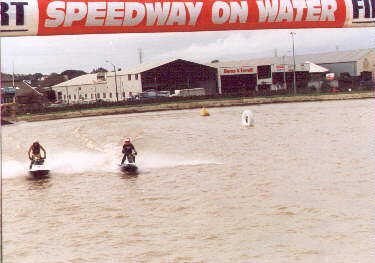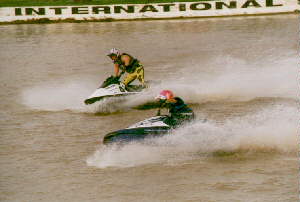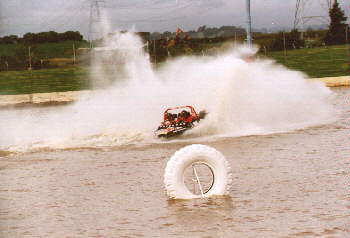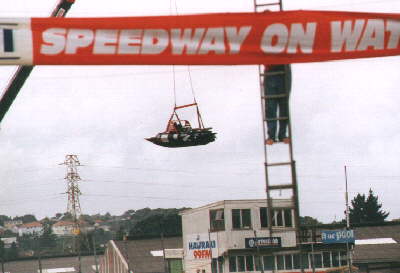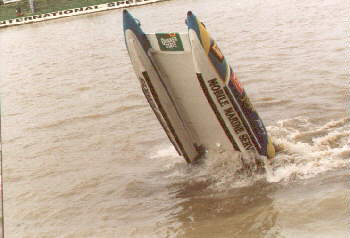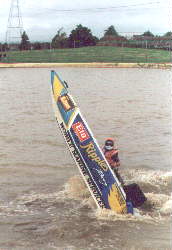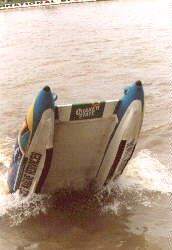THE ACTION PHOTOGRAPHER
Ian Abrahams
Preview of Speedway on Water.
Saturday 25th April 1989, 5.p.m
ian.abrahams@xtra.co.nz
Anzac Day
They have filled Waikaraka Park with water.
The speedway track is flooded.
On Saturday, starting at 5 o'clock there will be a world's first.
Speedway on Water. Jet Skis, Jet Sprint Boats and ThunderCats
racing on a closed course circuit, in a stadium with concrete walls
under lights.
There are 40 Jet Skis coming. They will race in four classes.
Pro Women Runabouts, Poles, Limited Sports and Runabouts.
At the moment the programme calls for the Jet Skis to race 5 lap races
five in a race from a standing start.
There is a course laid for the Jetskis which incorporates 5 left turns
and two right turns. The craft will be hard out along the Start/Finish straight
in front of the main grandstand. The Jet Skis will loop around the containers set in the middle of the course.
The back straight of the Speedway track is not used as a straight for the Speedway on Water
meeting. The stadium is on a bit of a lean and the back straight of the dirt track is too shallow to allow
the boats sufficient water to safely race.
There are 10 Jet Sprint Boats who will race the clock.
The boats vary in performance with the real grunter in the pack being
a fuel injected, supercharged V8. The jet Sprints will have several runs
in what is a very tight course. They will be made to race through
an open sided shipping container, do a 360 spin around a buoy set
10 metres from the containers and come back through a second open sided
container placed right alongside the other.
The Jet Sprinters have a different, tighter, course to the Jet Skis
and the ThunderCats but still have a flat out straight infront of the
main grandstand. The Jet Sprinters move a lot of water
and will have trouble with their wake bouncing off the walls and
making the boats bounce in the rough water.
On the courses that Jet Sprint Boats normally race the water
is sprayed up over a bank.
They will run two laps of the course
and it may be necessary to have a slight pause between the laps
to allow the water to settle.
It is very possible that one of the Jet Sprinters could hit the concrete wall
if they lose it. The course has been reset after three of the boats practised
and a decision will be made on Saturday about the course. Safety is paramount
and to ensure that a boat which loses it's motor, and therefore it's steering,
doesn't destroy itself on the concrete wall or in the wire netting above the
concrete the track design will change if necessary.
The Jet Sprint Boats will be lifted in and out of the water by crane.
The driver and navigator will be strapped into their boat and then lifted through the air.
These boats are incredible to watch, and the awareness that they are steered by
changing the direction of the jet unit whick also provides the propulsion.
If the motor stops there is no steering and the boat just skips across the water towards it's accident.
Also programmed are wake boards. Krazies with a wheel-less skate board
strapped to their feet, being towed, at speed, accross the water and deliberately crossing the
tow boat's wake. These guys want the wash bouncing off the concrete
and unlike the boats that will racing will deliberately go close to the
walls.
The other race boat class at the Speedway on Water meeting are mind blowing.
They are a twin hulled inflatables, short in length and with a 50 h.p.
outboard.
They race two up, a driver and crew, and will run at nearly 70 k.p.h.
down the front straight at Waikaraka Pond. They pull wheelstands and at their Nationals
at Mt Maunganui earlier in April the ThunderCats were getting serious air whilst jumping over 5 foot swells.
By serious air we are talking 30 feet in the air. The back wash
and confused wakes at the Speedway in Water meeting will not worry these boats.
Watch for them in their warm-up lap lift out of the water. For the
cameras on Thursday the ThunderCats pulled some wheelies virtually
on a dime. They dropped the ballast, the crew, ashore and the drivers stood their boats on the props.
The ThunderCats intend to have 16 boats at the meeting. Depending on water conditions, and wind, they will start either
3 or 4 in race, from a standing start, lined up across the track like Solos and Side-cars start.
They will actually have two races on the water at the same time (6 or 8 boats).
One race will start heading towards cementry bend on the front straight.
The other race with the rest of the field will start on the middle straight
and head towards the pit bend. The Thundercats will race on the same course laid for the Jet Skis and bumping into each
other is inevitable.
There are 56 races or runs programmed, but that will change for sure,
and the Speedway on Water meeting will finish with
30 or so star shells going bang 2000 metres above Waikaraka Pond.
They will be fired out of mortars set on a barge in the middle of
Waikaraka Pond's infield. Heaven help the racer of he loses control and
sets off the star shells by accident. Heaven help the television crew who will be filming the meeting
from on top of the containers right next to the fire works barge if the
star shells go off accidentally. The expert says it can't happen.
What is happening, in spite of the amatuer sooth sayers predictions, is Speedway on Water,
under lights in an arena in the heart of Auckland.
Click here to go back to the home page:
Click here to go to a photo essay of the meeting:
